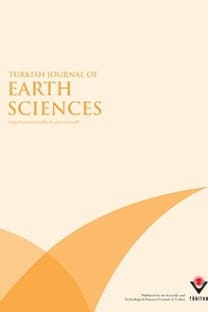Reducing uncertainty with fault seal analysis: A case study of Jherruck Block, Lower Indus Basin, Pakistan
Reducing uncertainty with fault seal analysis: A case study of Jherruck Block, Lower Indus Basin, Pakistan
___
- Allan US (1989). Model for hydrocarbon migration and entrapment within faulted structures. American Association of Petroleum Geologists Bulletin 73 (7): 803-811.
- Aziz MZ, Khan MR (2003). A Review of Infra-Cambrian Source Rock Potential in Eastern Sindh, an analogue to Huqf Group of Oman. Infra – Cambrian play of Eastern Sindh, Pakistan.
- Barclay F, Bruun A, Rasmussen KB, Alfaro JC, Cooke A et al. (2008). Seismic inversion: reading between the lines. Oilfield Review 20: 42–63.
- Berg RB, Avery AH (1995). Sealing properties of Tertiary growth faults, Texas Gulf coast. American Association of Petroleum Geologists Bulletin 79: 375-393.
- Bouvier JD, Kaars-Sijpesteinj CH, Luuesner DF, Onyejekwe CC, Vanderpal RC (1989). Three-dimensional seismic interpretation and fault sealing investigations, Nun River field, Nigeria. American Association of Petroleum Geologists Bulletin 73: 1397-1414.
- Cooke D, Cant J (2010). Model-based seismic inversion: comparing deterministic and probabilistic approaches. CSEG Rec. 35: 28–39.
- Doughty TP (2003). Clay smear seals and fault sealing potential of an exhumed growth fault, Rio Grande rift, New Mexico American Association of Petroleum Geologists Bulletin 87 (3): 427-444.
- Gibson RG (1994). Fault zone seals in siliclastic strata of the Columbus Basin, Offshore Trinidad. American Association of Petroleum Geologists Bulletin (78): 1372-1385.
- Gong JM, Liao J, Liang J, Lei BH, Chen JW et al. (2020). Exploration prospects of oil and gas in the North-western part of the Offshore Indus Basin, Pakistan. China Geology 3 (4): 633-642.
- Jadoon, SURK, Lin D, Ehsan SA, Jadoon IA, Idrees M (2020). Structural styles, hydrocarbon prospects, and potential of Miano and Kadanwari fields, Central Indus Basin, Pakistan. Arabian Journal of Geosciences 13 (2): 1-13.
- Kadri IB (1995). Petroleum geology of Pakistan. Pakistan Petroleum Limited. Pakistan.
- Kazmi AH, Jan MQ (1997). Geology and tectonics of Pakistan. Graphic publishers.
- Kazmi A, Rana R (1982). Geology and Tectonic of Pakistan, Graphic publishers Karachi Pakistan, Geological Survey of Pakistan.
- Kearey P, Brooks M, Hill I (2013). An introduction to geophysical exploration. John Wiley & Sons.
- Knipe RJ (1997). Juxtaposition and seal diagrams to help analyze fault seals in hydrocarbon reservoirs: American Association of Petroleum Geologists Bulletin 81: 187-195.
- Lindsey NG, Murphy FC, Walsh JJ, Watterson J (1993). Outcrop studies of shale smears on fault surfaces: International Association of Sedimentologists Special Publications 15: 113- 123.
- Raza HA, Ahmed R, Shaji, Ali SM (1989). Petroleum zones of Pakistan: Pakistan Journal of Hydrocarbon Research 1 (2): 21–56.
- Shah SBA, Abdullah WH (2017). Structural interpretation and hydrocarbon potential of Balkassar oil field, eastern Potwar, Pakistan, using seismic 2D data and petrophysical analysis. Journal of the Geological Society of India 90 (3): 323-328.
- Shah SI (2009). Stratigraphy of Pakistan. Government of Pakistan Ministry of Petroleum & Natural Resources Geological Survey of Pakistan.
- Tahirkheli RK (1979). Geology of Kohistan and adjoining Eurasian and Indo-Pakistan continents, Pakistan. Geological Bulletin, University of Peshawar 11 (1): 1-30.
- Wakefield MI, Monteil E (2002). Biosequence stratigraphical and paleo environmental findings from the Cretaceous through Tertiary succession, Central Indus Basin, Pakistan. Journal of Micropalaeontology 21 (2): 115-130.
- Yielding G, Freeman B, Needham (1997). Quantitative fault seal prediction: American Association of Petroleum Geologists Bulletin 81: 897-917.
- ISSN: 1300-0985
- Yayın Aralığı: 6
- Yayıncı: TÜBİTAK
İ. Tonguç UYSAL, Ezgi ÜNAL İMER, Andreas SCHACHNER, İsmail Ömer YILMAZ
Halim MUTLU, Ali GÖKGÖZ, Mehmet Ali AKMAN
Wide-area ground deformation monitoring in geothermal fields in western Turkey
Gökhan ASLAN, Hakkı AYDIN, Ziyadin ÇAKIR
Mudassar NAWAZ, Muhammad Rustam KHAN, Umair Bin NISAR, Muhammad Rizwan MUGHAL
